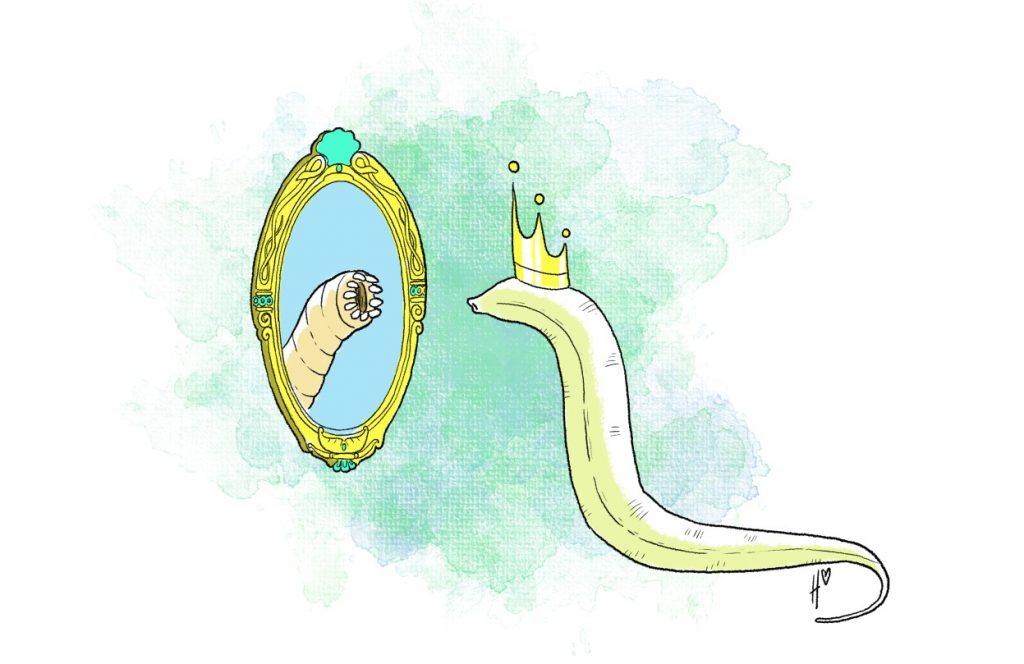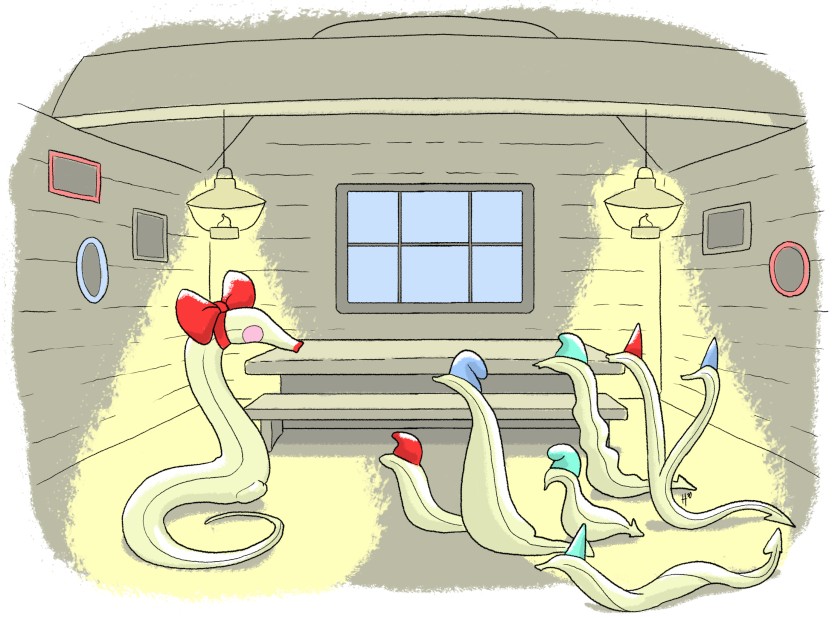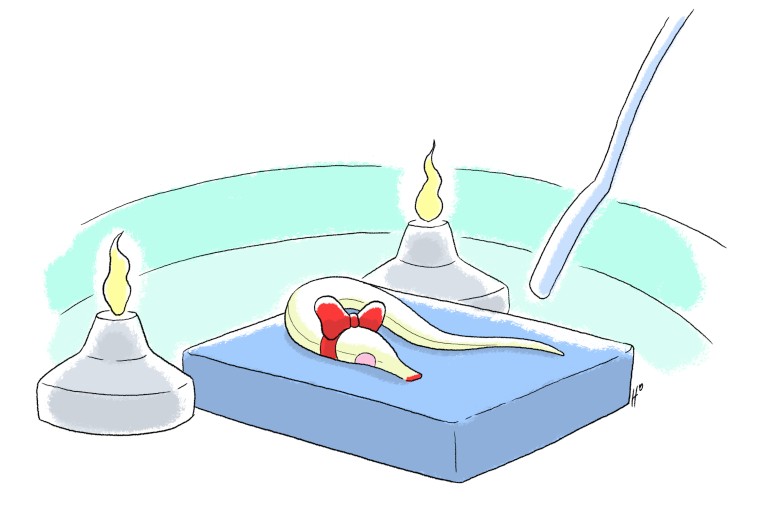
Authors: Simonetta SH, Diogo JV (2021)

Magic mirror on the wall who is the fairest of them all?
Once upon a time, in a distant kingdom of the world, a vain Rhabditis Queen received very unpleasant news [1]. The magic mirror on the wall, which always tells the truth, told her about a beauty that lives near Bristol’s suburbs [2]. -Snow White Worm is her name, and she crawls in the darkness of the forest herb. The Majesty very angry and without much hesitation, sent the soldiers to burn her in the Bunsen incinerator [3].
[1] In 1900, Maupas initially named the nematode species Rhabditis. Both C. briggsae and C. elegans (then known as Rhabditis elegans) were placed into a new subgenus Caenorhabditis in 1952. The subgenus was later elevated to a genus in 1955. [2] C.e. reference strain was collected in 1951 from mushroom compost in Bristol, England [3] In the lab bench, worm picker is disinfected after each worm is picked using Bunsen burner.

– You have always been good to me
The huntsman was cold shocked! Snow White Worm perfection deserved to be preserved [4]
The beauty crawled away, far into the woods, blasting with animal species, without stopping… Uaa! [5] Simpler and humbler, faster and clearer than snow. Animated with strong nerves and pleasant sympathy, she moved forward and reverse over the lands of other kingdoms [6]. Suddenly, she felt safe arriving at a small place in Cambridge, her new home to stay. There she found good food and took a little nap on the Petri’s bed.[7]
[4] C. elegans stocks can be frozen and thawed multiple times while maintaining viability [5] It refers to gene conservation between species. BLAST bioinformatic tool is used to compare sequences UAA=stop codon. [6] Description of C.e. anatomy and behavior [7] Sydney Brenner developed the research on C. elegans in the MRC Laboratory of Molecular Biology in Cambridge. Standard C.e. culture conditions has been implemented using NGM Petri dishes.

What kind of magic is this?
The Seven Dwarfs were heading home from a long working day at the EtMeSu mines [8]. What a surprise to find the naive beauty! – “Stay here, with us. We’ve got cod”, said Dumpy [9].- “That’s great,” said Snow White Worm. “But if I were to stay here at your home, I would have to do something for all of you”. -“Do you know how to read? You can read us all our genomes and plot our cell maps”[10]. To celebrate their new friendship, Snow White and the Seven Dwarfs danced turnings the night away.
[8] Ethyl MethaneSulfonate (EMS) is the most commonly used mutagen in C. elegans and by far the most potent (Brenner, 1974) [9] Mutations in the Caenorhabditis elegans dpy-13 (dumpy) gene result in a short, chunky body shape. “cod” is a Copulation Defective mutant [10] In a series of studies, culminating in a paper published in 1983, John Edward Sulston has analysed and described the total cell lineage of the nematode making it the first organism for which the origin of every cell is exactly known. In addition, C. elegans was the first animal whose genome was sequenced (C. elegans Sequencing Consortium, 1998), and has been an exemplar in the application of genomic data to functional biology in animals.

What kind of poison is it?
Early on, Snow White Worm was keen on experiencing weird things to pass the time at the Dwarfs’ house. She tried many potions and recipes getting a tasty set of new feelings, and forward and reverse screenings [11]. Inducers and repressors, too many molecules from which to learn lessons. The story goes that the apple was sent by the Queen. And the dangerous poison was sensed by Snow White Worm with just a single dose [12]. The beauty Snow White Worm fell asleep in a long-frozen state that felt to her like she was dying, quiet as a dauer [13].
[11] recipes = lab protocols. Forward genetic screen is an approach used to identify genes responsible for a particular phenotype. Reverse genetic screen, on the other hand, analyzes the phenotype of an organism following the disruption of a known gene. [12] single dose refers to the typical approach when running a primary chemical screening [13] In unfavorable conditions, including overcrowding, limited food, and high temperature, C. elegans undergoes development to a specialized third larval stage called the dauer. The dauer state allows C. elegans to commonly survive for up to 120 days.

But there was nothing to help poor Snow White Worm
She was placed in a soft bed to preserve her intact body for a while. The beauty stood absolutely still in her deep sleep-like state. She didn’t even show responses to bright light, heat shocks, cold shocks, and head or tail touches [14]. How difficult it was to guess her state of mind…One could count her beats but there were no signs of body movement [15]. How could we tell if she was alive or dead? Could we wake her up with a magical injection or a plentiful golden beads bath? [16] Day and night they kept watching over beauty, hoping for a circadian clock that would make her awake [17].
[14] typical stymulus, some of them used to check if a worm is alive [15] C. elegans feeds on bacterial food via rhythmic contractions and relaxations of its pharynx, a neuromuscular pump with similarities to the vertebrate and invertebrate heart. beats = pharyngeal pumping. [16] microinjection and golden beads bombardment are methods to generate transgenic worms [17] An interesting exception to circadian coordination of sleep timing by the circadian clock is Caenorhabditis elegans, where sleeplike lethargus is bound to the progression through development. Although development proceeds with precision in the worm, it lacks key clock properties of circadian systems.

He was searching for her, far and wide.
And nobody knows how he found her in the wide field. But likely the soft odor of a young beauty attracted the prince to rescue her [18]. A chemical feeling which places the bodies to go in the same direction. He stopped moving forward, pressed the princess body, and began moving backward. In four or six steps [19], the prince behaviour awaked Snow White Worm, who finally responded to one stimulus…. “the first kiss of love”.
[18] Sex pheromones facilitate reproduction by attracting potential mates and altering their behavior and physiology. In C. elegans, males and hermaphrodites secrete similar blends of pheromone molecules, two of which are present in different relative concentrations: ascr#3, which is more abundant in hermaphrodites, and ascr#10, which is more abundant in males. [19] Male mating is the most complex behavior exhibited by the nematode C. elegansand involves the steps of response, backing, turning, vulva location, spicule insertion, and sperm transfer.

They returned to the kingdom
They used a riding animal to go far away [20], and to reach the castle again, undertaking a long journey to the glory. One full of happiness and novel prizes, with followers from all over the globe [21]. And the furious Queen disappeared mysteriously like a ghost, as swallowed by a hungry arachnid specie full of hairs [22]. Nowadays, after many years of historical research, the Queen identity has been finally revealed: She was a Briggsae! [23]
[20] Despite being a free-living nematode, C. elegans is sometimes associated with carrier animals in nature, such as isopods, snails and insects. [21] three Nobel Prizes have been awarded for work on C. elegans: 2002 to Brenner, Sulston, Horvitz for the study of apoptosis. 2006 to Fire and Mello for their study of the mechanism of gene knockdown by RNAi. 2008 to Chalfie for his work on the GFP protein. [22] possible natural predators include small arthropods, such as mites or springtails [23] C. Dougherty first recognized the potential of C. briggsae , which had been found by Margaret Briggs in a pile of leaves on the campus of Stanford University in Palo Alto, California. Years later, Sidney Brenner settled on the related nematode C. elegans as the focus of his efforts because the elegans strain grew better than the briggsae isolate in his laboratory (Félix 2008).

And they lived happily for the rest of their lives
The prince and Snow White Worm soon became King and Queen. Like magic, they had hundreds of children… 1, 2, 3 ♫ 14 [24]. The worm dynasty turned into the pioneers of a fantastic genetic revolution. And they conquered the world, living infinite stories…some of them still unpublished [25]. In the end, our lovely Snow White Queen lived happily a long life, extending her lifespan and healthspan in a very significant way [26].
[24] A hermaphrodite that self-fertilizes can produce about 300 progeny because of the limited number of sperm, but if mating with a male occurs, the progeny number can increase to 1400. [25] unpublished manuscripst at C.e. research labs. [26] C. elegans is a popular model in aging research because it shares many of its genes with humans and because its short lifespan of only three to four weeks allows scientists to quickly assess the effects of genetic and environmental interventions to extend healthy lifespan.

they accompany us from heaven
Epilogue: Some years later, Snow White Worm was named the Bristol N2 empress [27]. Hopefully everyone will remember her name in the future, and will rise the flag of her victory in the animal kingdom. Snow White Worm’s ancestors rest in peace high in heaven, near Sydney [28]. And there in the clouds, the computer servers keep them alive every day as a digital legacy for everyone in the world…… Our world [29].
[27] The canonical wild-type laboratory strain N2 was derived from an isolate found in 1951 in mushroom compost in England. It is currently the reference strain [28] Sydney Brenner (face image behind) was born in Germiston, South Africa in 1927. He died in Singapore on April 5th 2019 [29] Wormbase, Wormbook, Wormatlas are some of the web tools daily used by worm researchers. [30]GAA… corresponds to the codon codification for the aminoacids “e-l-e-g-a-n-s”
